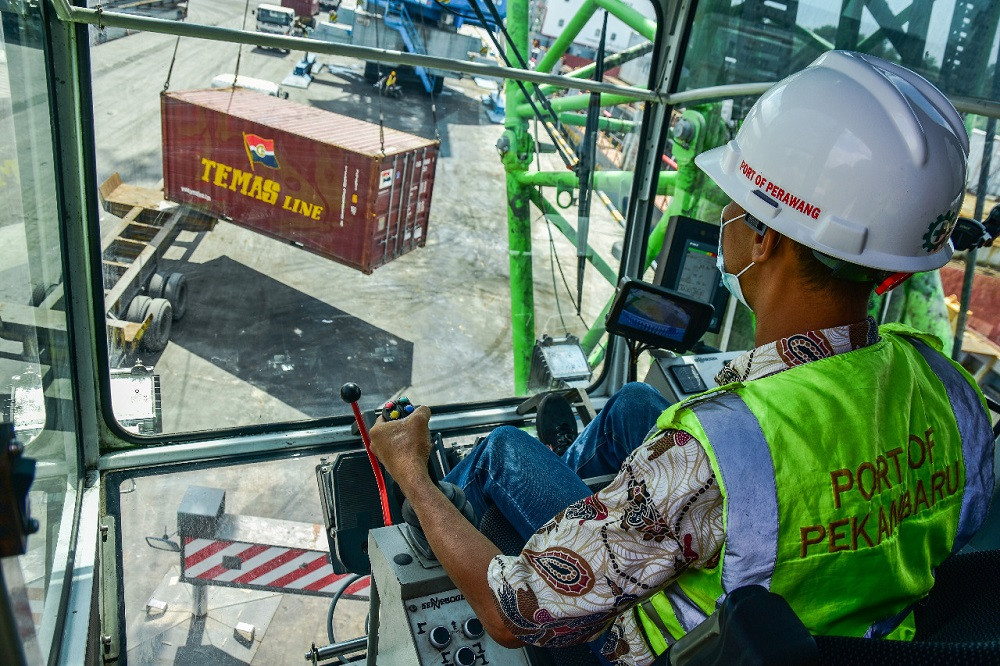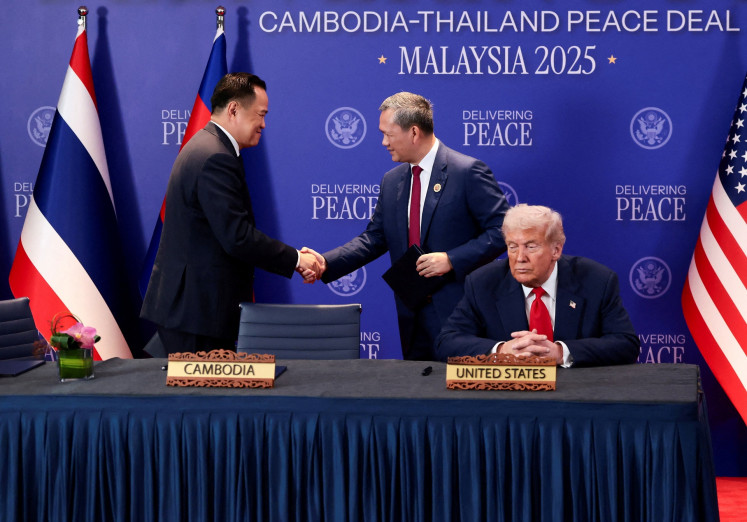Popular Reads
Top Results
Can't find what you're looking for?
View all search resultsPopular Reads
Top Results
Can't find what you're looking for?
View all search resultsPelindo merger: Toward liberated management
Lacking fresh ideas, the Pelindos have for decades run all sub-unit businesses under a single management.
Change text size
Gift Premium Articles
to Anyone
T
he State-Owned Enterprises (SOEs) Ministry has announced that the merger of Indonesia’s four port operators (Pelindo) will come into force on Oct. 1, integrating Pelindos 1 through 4, respectively based in Belawan, North Sumatra; Jakarta; Surabaya; and Makassar, South Sulawesi.
This merger could be seen as a political-economic policy to further strengthen the consolidation of state wealth. One thing is for sure, however. The management breakthroughs the new holding company will employ will be key.
The idea of integrating the four Pelindos has been discussed since the SOEs Ministry was established in 1998. Soon after being installed as SOEs minister in 1998, Tanri Abeng formulated his strategic program, which can be read in a single breath: restructuring, “profitization” and privatization. As a whole, this program aimed to get foreign capital resources as rapidly as possible, both to repay International Monetary Fund (IMF) loans and help the economy recover from the 1997-98 Asian financial crisis.
By pursuing these two goals, not only could Indonesia’s economy get a fresh wind, the state’s legitimacy, the financial crisis had deeply impacted, could be restored. Tanri’s program thus indirectly aimed to create a “cork” upon which state political authority could float.
Tanri’s program yielded the first foreign capital injections into the Indonesian economy after the Asian crisis when small parts of Semen Gresik, PT Telkom and Pelindo 1 and 2 were privatized. In a nutshell, although seemingly overstated, one cannot deny that the 1998 consolidation of SOEs had something to do with the recovery of Indonesia’s economy and politics.
It is from this perspective that the Pelindo merger should be considered. First, returning to Tanri’s program, the Pelindo merger could be subsumed into the restructuring cap. By linking the merger to the program, we could trace the earlier idea that something had to be done with the Pelindos.
Second, since the management of the Pelindos was accorded to the Indonesian government after the 1949 Den Haag Roundtable Conference, there haven’t been significant developments in their business model.
Although it should be admitted that there have been some advancements in management, capital and, here and there, human resources during this long period, a significant leap forward could not be expected from the previous “conventional” management and structure of the Pelindos.
This is because their operations have been trapped by two main obstacles. First, the ports are scattered throughout Indonesia’s geographical landscape. While Pelindo 1 is based in Belawan, North Sumatra, Pelindo 2, 3 and 4 are based in Jakarta, Surabaya and Makassar, respectively. As a result, their economic impacts are segmented and felt only in their surroundings. We, therefore, cannot expect the economic impacts to extend nationally.
Second, in doing business, each of the Pelindos grasps the business units under its control in a strait-jacket manner. Lacking fresh ideas, the Pelindos have for decades run all sub-unit businesses, such as containers, logistics, non-logistics, marine services and other related port services under a single management.
Consequently, caught in this region-based business management model, coupled by conventional and “illiberal” forms of corporation, the scattered centers of Indonesia’s ports offer no promising development. It is no wonder, therefore, that although their bases stretch across the country’s vast geographical landscape, as of 2019, Indonesia’s port business was stuck in 11th place globally.
It is against this background that creative and imaginative ideas should be sought out to create breakthroughs and remove the regional and management obstacles. These creative and imaginative ideas are crucial for the future development of the Pelindos, otherwise the stagnation of the supposedly great economic potential of the Indonesian port companies will persist.
SOEs Minister Erick Thohir has offered one breakthrough idea: merging the Pelindos. He commissioned his deputy, Kartika “Tiko” Wirjoatmodjo, to accomplish this. Under Tiko, the merger was formulated. By using their professional backgrounds, Erick and Tiko created an astute strategy in the fashion of, in my own phrase, liberated management.
First, all of the existing Pelindos will be integrated into and work under a single umbrella of management, what is unofficially called the “surviving Pelindo”. Through the elegant design of the merger, this “surviving Pelindo” will act as a holding company. The merger will not only remove the regional obstacles but will also create a nationwide Pelindo.
In other words, the merger will transform the region-based port corporations into a single national one. This is unprecedented and a historical breakthrough.
Second, Erick and Tiko are liberating each of the Pelindo business units to develop optimally into national corporations. They will form independent cluster businesses: (1) container, (2) non-container, (3) logistics and hinterland development and (4) marine, equipment and port services.
Thus, through the merger, Indonesia will have four independent port service corporations whose operations encompass the entire country. As is the case with the first, this is a striking and substantial transformation, since they clusters were previously merely sub-units of the regional Pelindos. Doesn’t this mean that, although acting as sister companies of the newly born holding, the merger program will eventually create four new national-level port-related service companies?
It is in this context that liberated management applies. Why? In addition to the creation of the Pelindo holding company, the merger simultaneously gives birth to four national sister companies. Suddenly, through Erick and Tiko’s merger, we realize that the centuries-old regional trap and the “strait-jacket” model of their sub-unit businesses can simultaneously be overcome.
After the merger, both the holding and its four subsidiaries, which were previously lodged within respective Pelindos, can independently articulate themselves as nationwide corporations. And, as has professionally been calculated, the consolidated Pelindo will leap up to sixth place in the global rankings.
The merger, therefore, is a new path to create a much larger contribution to, as Adam Smith put it, the wealth of the nation.
***
The writer is the cofounder of the Institute for the Study and Advancement of Business Ethics (Lspeu Indonesia).










